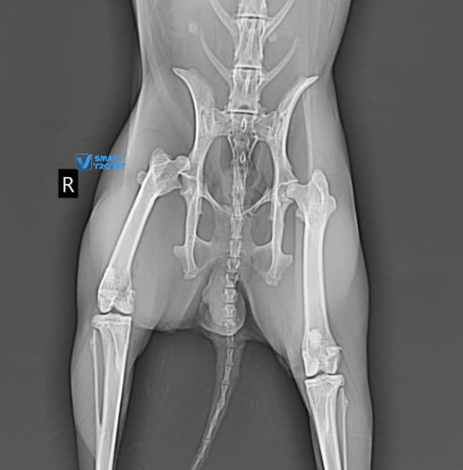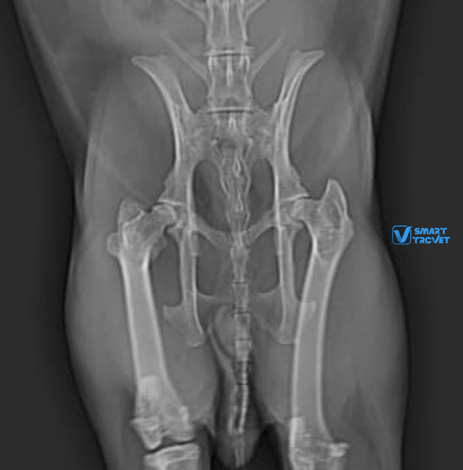
Introduction
The hind limbs of rabbits exhibit specific anatomical characteristics related to their locomotion by jumping. Compared to the forelimbs, the hind limbs are larger and stronger, with a substantial tarsus and metatarsus. Luxation of the coxofemoral joint is uncommon in rabbits, with limited documentation available on its occurrence. While this condition is the most common joint luxation in companion animals, specific prevalence rates in rabbits are not well-documented. Nonetheless, awareness of this condition in rabbits remains important.
Case Description

Lili, a two-year-old female rabbit, fell from her owner’s arms, resulting in lameness of the right leg. Radiographs of the pelvis and right hindlimb (excluding the area from mid-tibia to foot) were prepared and found to be of good quality. The radiographs revealed a complete luxation of the right coxofemoral joint, with a dorso-cranial displacement. Both acetabula and the left hip appeared normal. Hip dysplasia was not present. All other bones and joints of the hind limbs were normal, with no additional radiographic abnormalities identified. The final diagnosis, based on the radiographic findings, was traumatic dorso-cranial luxation of the right hip joint.

The hind limbs of rabbits exhibit specific anatomical characteristics related to their locomotion by jumping. Compared to the forelimbs, the hind limbs are larger and stronger, with a substantial tarsus and metatarsus. Luxation of the coxofemoral joint is uncommon in rabbits, with limited documentation available on its occurrence. While this condition is the most common joint luxation in companion animals, specific prevalence rates in rabbits are not well-documented. Nonetheless, awareness of this condition in rabbits remains important.
A Brief Review of Coxofemoral Luxation in Small Animals
Coxofemoral luxation, or hip dislocation, occurs when the femoral head displaces from the acetabular socket in the hip joint. Both hips can be affected, leading to bilateral luxations. Major stabilizers of the hip joint include the joint capsule, ligament of the head of the femur, and the dorsal acetabular rim, while minor stabilizers include the ventral acetabular ligament, gluteal muscles, hip adductors, and hip abductors. At least two major stabilizers must be disrupted for luxation to occur.

Causes:
- Trauma: Commonly seen after vehicular accidents or falls.
- Spontaneous luxations: May occur without apparent cause.
- Unknown trauma: Sometimes the cause remains unclear.
Clinical Signs:
- Craniodorsal luxation: Limb held with adduction and external rotation; stifle rotated outward, tarsus inward.
- Ventral luxation: Opposite positioning; limb abducted and internally rotated.
- Bilateral luxations: Often result in inability to walk.
Diagnosis:
- Confirmed through radiographs (two orthogonal views).
- Rule out other abnormalities that could prevent closed reduction.
Treatment:
- Closed reduction: Aim to reduce the luxation, stabilize the joint, and protect articular cartilage.
- Surgical intervention: (e.g., femoral head and neck ostectomy) if closed reduction fails or complete luxation occurs.
Conclusion
Although data on the prevalence of coxofemoral luxation in rabbits are insufficient, the condition is reported in the literature. Comprehensive documentation on this condition in rabbits is lacking. Pet owners suspecting hip issues in their rabbits should consult a veterinarian for proper evaluation and guidance.

